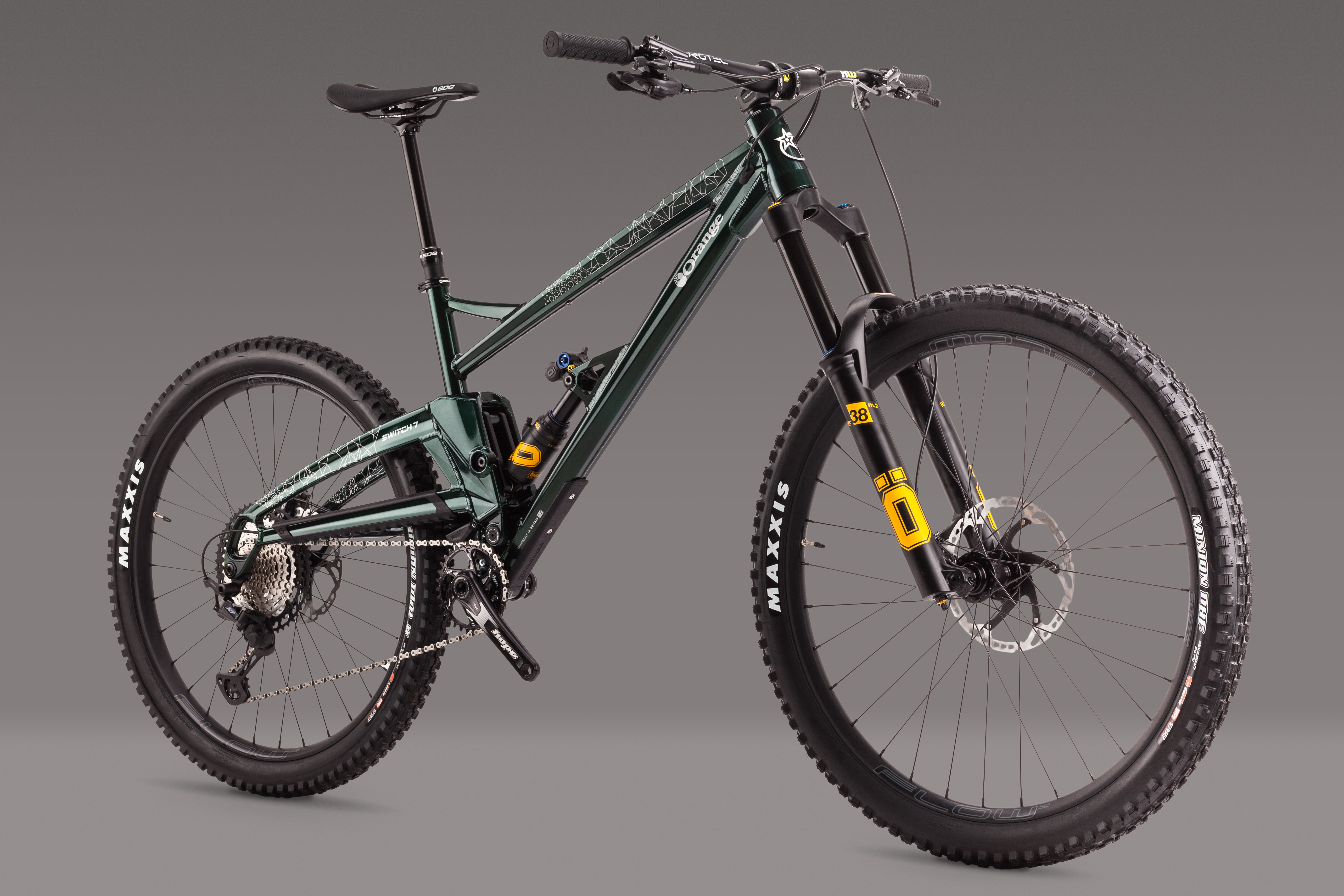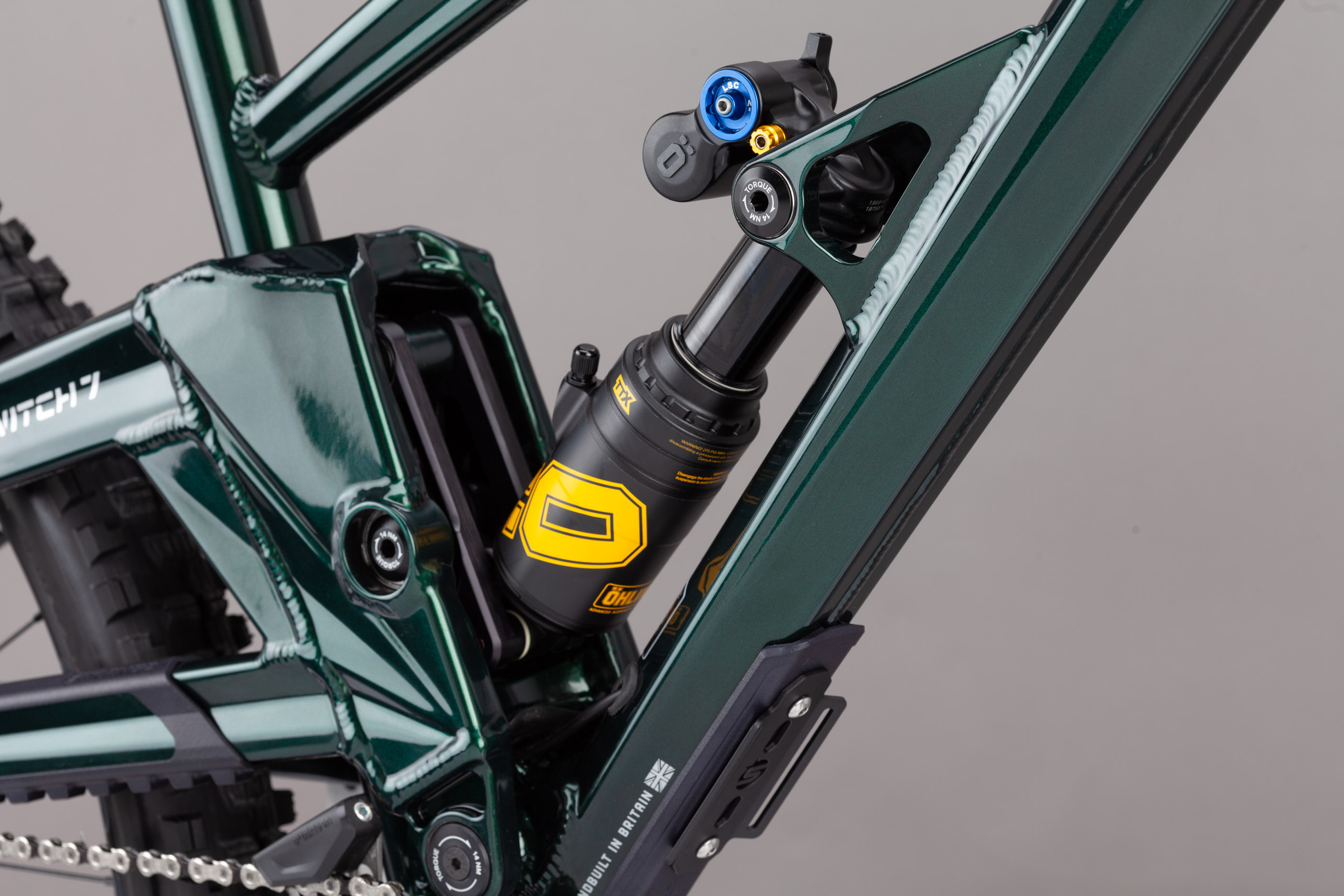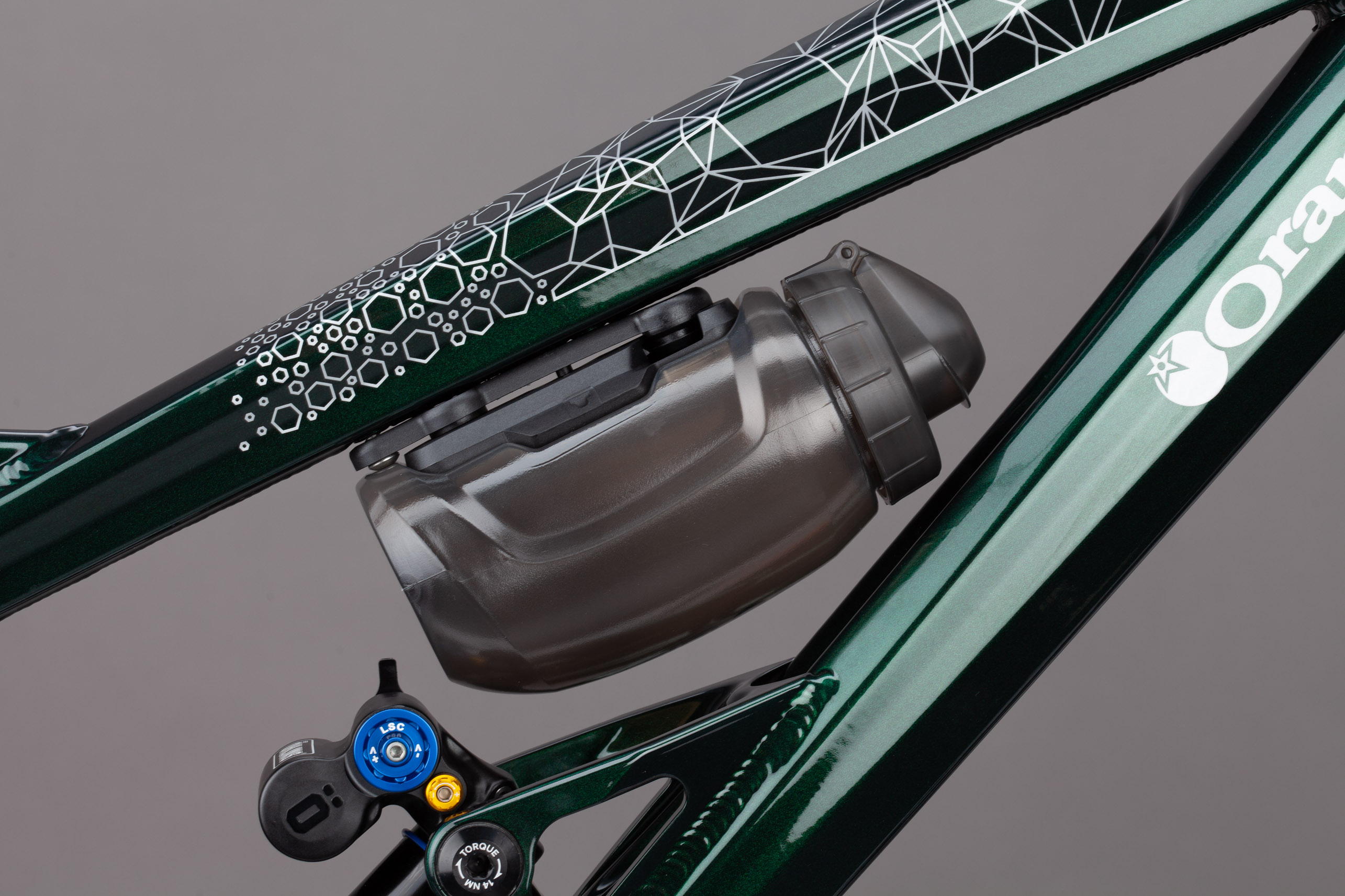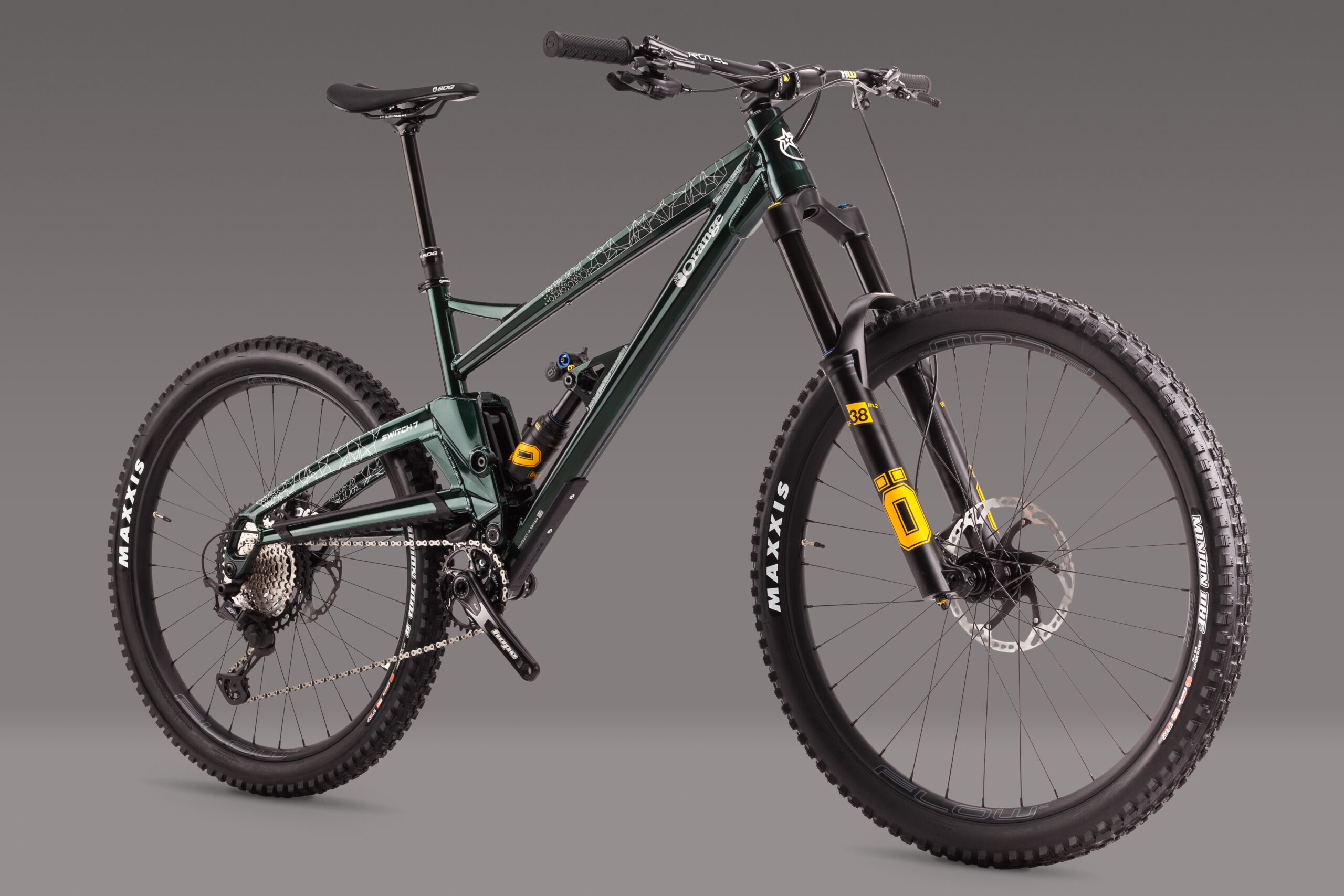The Orange Switch 7 is a 170mm travel MX wheeled enduro bike using a linkage-driven trunnion shock, mounted low in the frame.


Orange Switch 7 SE spec
- Sizes: S, M, L, XL
- Colour: British Racing Green
- Decals: Silver Decals
- Frame and Fork: 6061-T6 Monocoque UK Formed Custom Aluminium Tubing
- Wheel Size: MX – 29/27.5.
- Rear wheel travel: 170.
- Fork: Ohlins RXF 38 M.2 Air 170mm 29
- Swingarm: Bolt Type Allen Key Head (Boost 148mm Hub)
- Rear Shock: Ohlins TTX2 Air 205×65
- Headset: FPD 44mm / 56mm zerostack
- Crankset: Hope Black 32t
- Rear Mech: Shimano XT 12spd
- Chain: KMC 12spd
- Shifters: Shimano XT 12spd
- Cassette: Shimano XT 10-51T 12spd
- Chain Device: E13 Vario Compact Guide
- Bottom Bracket: E13
- Wheelset: Stans Flow Mk4 + Hope Pro 4 (Black) 29 + 27
- Tyres: Maxxis Minion DHF 2.5 3c EXO+ 29 / DHR II 2.4 3c EXO+ 27.5
- Brakes: Shimano XT Trail 203/180
- Seat Clamp: Strange Bolted
- Stem: Burgtec Enduro Black 42.5mm
- Saddle: SDG Strange Bel Air III
- Handlebars: Burgtec RideWide Enduro 800mm
- Grips: Strange Grappler Lock-On
- Seatpost: SDG Tellis 150mm
- SRP £,7400
Best bits from Orange Bike’s considerable press release…
“Although the frame silhouette is still very intentionally that of an Orange, a great deal has changed, but also much remains the same. This is a completely UK made frame, manufactured from flat sheets of aerospace grade aluminium to individually custom-fabricated tubes, seam-welded for each specific purpose, working in harmony with CNCed components from aluminium billet meticulously modelled and analysed.
“This all produces an aluminium frame with a weight less than that of many ‘carbon’ frames in its category. It also means we have a product that’s strong, durable and fully recyclable at the end-of-life cycle.”
Why now?
“Performance single-pivot is and always will be the core of the Orange Bikes philosophy; that will never change. We believe in the benefits of a single-pivot system, its performance and its unique ride feel that make an Orange Bike; and is not as simple as you think.
“The new Orange Switch 7 was born out of a need simply to go faster on the race track!
“So why now? That’s not to say that we haven’t done a linkage bike before!
“When we conceived the idea of a new Orange Factory Racing team to compete in the EWS the seeds of a new enduro race bike were already germinating.
“A trunnion mounted shock in our factory spec runs on a full complement of bearings instead of bushings, both the trunnion mount and lower eyelet, along with all the frame pivots run on cartridge bearings allowing us to achieve as low as possible break away force, providing incredible sensitivity to the initial part of the shock’s stroke.
STRANGEr things
“The lynchpin of this dynamic bike is our STRANGE power link.
“The STRANGE power link allows us to have a considerably more progressive shock curve than we have used previously. It’s this shock curve which adds to the truly bottomless feeling that the Switch 7 delivers, but also allows the use of both high-volume air cans or coil shocks. Through the rear shock’s travel, the leverage ratio falls from 2.85 to 2.10. Looking at shock force, this means the real working progression is 36%. The curve was developed so it maintains the fun direct feel that Orange bikes have become famous for while adding the big travel requirements of a very progressive platform.
“With the bike’s kinematics sorted, this race machine also benefits from our lowest pivot position to minimise pedal kickback, and drivetrain induced interference. Anti-squat numbers for the Switch 7 in the 32/52t gearing start at 130% falling to 105% at full travel. Around dynamic sag the anti-squat is at 120%, this means that the bike will be efficient on the pedals when pushing hard in or out of the saddle.
Other new stuff
“An additional request from the Orange Factory Racing team was to have an option to increase the bike’s bottom bracket height, we’ve done this using an additional pair of “dog bone links” which are available separately and increase the bikes BB height by 5mm with only a half-degree steepening of the head angle, giving the rider the choice when the terrain demands it without adversely affecting the steering geometry.
“The frame is covered in features not previously seen on our bikes and are the result of meticulous analysis and testing. The Switch 7 sports a 49/56 ZS headtube, this has helped improve both strength and stiffness at the front end of the bike, increase the surface area for welding between head tube, down tube and top tube as well giving us enough room to drop the downtube slightly to allow for a water bottle in the front triangle. To make access even easier new tooling was produced to create a recess on the top side of the down tube.
“Technology developed on other models also plays it part, the Switch 7 has an asymmetrical swingarm design similar to the recently released Stage 6 Evo, this swingarm allowed us to increase the bike’s vertical stiffness whilst tuning its lateral compliance, producing a bike with a direct feel but with buckets of grip.
More than a feeling
“Focussing on chassis dynamics has been important throughout the Switch 7’s testing program. It’s easy to make a bike too stiff and effectively end up with reduced traction and a “dead” or “wooden” feel to the bike’s ride. A large part of the additional grip being produced by this bike is down to a design that isolates the shock from the lateral forces coming through the frame particularly during hard cornering and large compressions, so the shock is only loaded in a linear manner. There were a few reasons for doing this; first to ensure the best possible life of the shock and bearings, second to minimise any external input that could increase friction and hamper the shock’s performance, and third this linkage design allowed us to control the swingarm’s lateral compliance using custom designed and manufactured tubes specific for the job.
“Throughout the design process we were conscious of our reputation for low maintenance bikes. We made every effort to conceal the majority of our bearings within the front of the swingarm, out of harm’s way and safe from jet-washers.
“Bikes will come with a 5 year bearing warranty for the original owner and any original owners outside of that period will receive heavily subsidised pricing.
“The icing on the cake is our new chainstay and downtube protectors. These keep your pride and joy looking sharper for longer, help dampen chain slap, impact from stones and are the final details on a bike that has seen an incredible amount of development.”








Q&A with Alex Desmond, Senior Design Engineer:
Q: Talk us through the process of how the Orange Switch 7 was designed.
“We started by agreeing on what we wanted the bike to do. It should be that one bike in your garage that you could win an EWS race on, take to a bike park and ride a trail centre. It should feel fun and efficient in all of those settings.
“We wanted a water bottle in the front triangle, progressive kinematics, reduced pedal kickback, good anti-squat, trunnion mount, bearing mount shock, everything. We also needed to use the existing Orange manufacturing process and conceal the linkage out of the way of mud. We all also liked the idea of mass centralisation moving all the weight as low and as central as possible.
“We started off with 12 different concepts, which we gradually refined down to a final design and agreed on suspension layout and geometry. At this point, we built a prototype 3D CAD model of the bike and we moved on to prototyping various parts of the linkage. We used a 3D printer to see how it would physically look and feel.
“After this, we started doing Structural Finite Element Analysis (or FEA) which basically looks at how strong and stiff the frame is under different conditions. We wanted to match our current stiffness characterises to ensure the bike still generated grip and felt like an Orange.
“We also wanted this frame to be our strongest to date all whilst trying to keep the overall weight below our nearest carbon rival. This took quite a while to sort out but then when we had that done we looked at how to make it and then made a set of prototype bikes. We took mine secretly around to all the EWS rounds last year and rode it with the Factory race team on the EWS tracks the day after the races when everyone else had moved on to the next round. This allowed us to make a direct comparison to the current Switch 6 on the same trails with team riders. The times were really impressive!
“We then spent about a year developing the bike and making gradual improvements. For example, we added in the water bottle dimple to make it ergonomically easier to grab the bottle. We moved to the tapered head tube which allowed us to use ZS56 bearings and increase the stiffness at the front without adding any weight. After testing, we came up with a method for an adjustable BB height too. This was all fed into the production design where we got 16 frames made to be physically tested and used by the Factory race team and our sponsored riders.”
Q: The Orange Switch 7 manages to maintain an Orange aesthetic but packs a lot more into that space, what sort of challenges has fitting everything into the frame caused?
“It was incredibly challenging, especially when figuring out how to weld it all together.
“3D printing mock-ups really helped us to get an understanding of what clearance we needed and where. We didn’t actually set out to maintain the aesthetic but we wanted to maintain the production process and its inherent benefits but also build on them.
“For example, the shock now pushes along the axis of the down tube which significantly reduces the stress in the down tube caused by shock loading. This is one way we were able to make the bike stronger without adding weight. The fact that the bike ended up looking similar in silhouette to other Orange bikes is really just a by-product of the engineering.”
Q: Previously you’ve worked in an environment where chassis dynamics played a big part in performance, can you tell us a little more about that and how it’s helped in the development of the Switch 7?
“Frame stiffness is critical in how a bike behaves.
“When a bike is leaned over, in the vertical axis the suspension is not active so you rely on frame flex to allow the bike to conform to the ground profile to maintain tyre contact and therefore grip.
“Honestly, it’s an area that is very well understood in the motorcycle and automotive world. In motorcycles, it’s called the flexural stiffness ratio and different categories of bikes have different ratios and stiffness associated with them. It’s why Ducati moved away from carbon in MOTO GP for example, because they couldn’t achieve the desired stiffness ratio or damping with carbon so they moved to aluminium.
“In pushbikes, it’s also critical to have a good level of vertical stiffness to ensure good pedalling efficiency. I was able to bring my background in FEA and stiffness analysis here.
“Because Orange manufactures at home in Halifax, we were able to very quickly produce a couple of different swingarm designs with different levels of compliance in the longitudinal and transverse axis as well as twist and analyse them.
“What we found is the current Orange single pivot bikes have a really good ratio. Basically, they have found this by physically building and testing and developing different swingarms over 30 years. We built on this a bit but this again gave us a target for the new bike.”
Q: What sort of character/riding traits did you expect from the Orange Switch 7 in the design phase?
“We knew it would generate a lot of grip because of the chassis design and shock curve. We also worked hard to keep it confidence-inspiring in steep, techy terrain but also fun, which is often a trade-off. We also knew it was light for the class of bike and had good mass centralisation so would jump well.
“We were less sure how the pedalling efficiency would play out, as shocks and lockouts impact on this as well as damper tunes. We had lifted the BB a bit to increase clearance too and gone for an anti-squat that was ideal for pedalling hard whilst standing as well as seated. We did very much have racing in mind.”
Q: Was there anything that surprised you once you started riding the prototype?
“The pedalling efficiency really impressed us, as did the sharpness of the steering. We’ve designed, worked on and ridden quite a few bikes over the years and the speed of this thing just blows my mind. We’re all really looking forward to seeing how the pro riders get on with it this year.

Q&A withAshley Ball, Owner of Orange Bikes
Q: You’re still heavily involved in the production and development of frames at Orange, what is it about that end of the business that you enjoy?
“I’m a designer an engineer and a multiple business owner but before all that I’m a third-generation sheet metal worker. I love to make things and I love to make them well.”
Q: You were responsible for the ST4, Blood and 225 to name a few of the famous linkage bikes Orange have produced over the years, why has it been so long since the last linkage bike?
“Yes, there have been a lot of prototype and development linkage frames over the years and several production ones too, more than a lot of people will be aware of I’m sure. At Orange we do an incredible amount of product design and real world development work, more than most and because manufacturing in house makes it possible. An idea becomes a ridable prototype very quickly. As a performance brand we have to stay on top of our game. Linkages inevitably fall into this. Damper technology and damper sizing available at the time can affect packaging or specific requirements needed in the performance of the chassis or both when considering the design brief can lead to needing a linkage. Race frames sometimes require a more focused approach to elements of the dampers performance and a linkage driven damper can aid with this. If we need a linkage to get the results we need then that’s what we do. We are known for our single pivot bikes and how well they perform but we are not a single pivot only brand. We haven’t done a linkage chassis for a long time because modern dampers are so good and are available in an incredible array of sizing and formats that we continue to achieve the performance we want without a linkage in most cases. At Orange if we don’t need it, it doesn’t happen our products are rated on performance not a trademark.”
Q: What does the Orange Switch 7 have to offer which separates it from the rest of the range?
“Increased grip, traction, suspension travel and speed combined with the ability to reduce rider fatigue when ridden flat out for sustained periods. In short, it’s a race bike.
“I like to ride bikes and I like bikes that need to be ridden. I like to feel what’s going on with a playful chassis that moves about and requires commitment. I still believe in the skill of riding a bike and how rewarding that is. Fast, capable and confidence inspiring but at the same time having a requirement for the rider to contribute. This is undoubtedly reflected in the bikes we make and what Orange stands for. Spend the time you save not servicing/replacing bearings and links riding your bike and perfecting your bike craft. These are performance products built for enthusiasts and those in the know.
“What changes with the Switch 7 is the stopwatch. The rewards are not solely measured in smiles per mile the reward is hitting a line perfectly time after time coupled to the ability to carry speed in, through and out of any given situation every time. Neat, tidy and precise. Don’t worry it’s still very much an Orange just with a slightly different brief.”
Q: What traits did you want the Orange Switch 7 to have?
“It had to look and feel like an Orange. Anyone who is familiar with the brand will instantly feel at home when they climb aboard a S7. Geometry is all modern Orange and the ride characteristics are there too just smoothed out and with an added air of seriousness.
“Chassis feel! I don’t buy into all this neutrality crap, to go fast you need to be able to feel what’s going on and where the limit is. We have increased control and reduced fatigue but not at the expense of chassis feel.
“The bike still needed to snap to attention and accelerate like all our full sus bikes do and never feel like its wallowing in overly active suspension travel. That goes for climbing too.
“The chassis needed that bit of forgiveness and give, in line with all our bikes, not too stiff and fidgety. Our monocoque chassis system is perfect in this regard.
“It’s taken a lot of development, but we have got there, and the end result is an Orange full sus bike, just with the wick turned up. I’m extremely happy with the outcome and the team I work with.”
Q: Will the linkage end up on all Oranges going forward?
“No – we currently make the best range of bikes we ever have. Our current crop of single pivot bikes are well and truly on top of their game. The strange link will appear on our more focused, longer travel bikes with 150-160mm travel plus.”







